

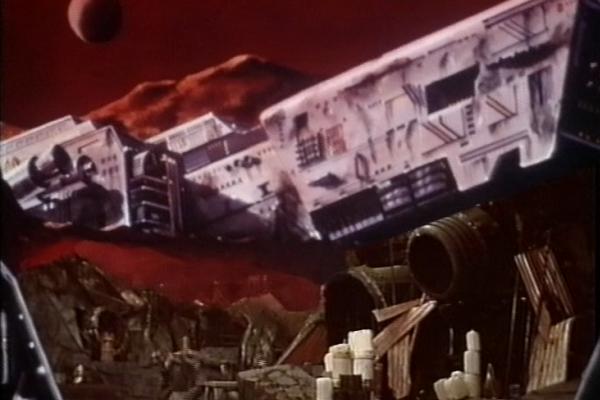
Okay, the concept that the future of mankind would still have mullet haircuts is a worrying one, but this ambitious attempt at world building on a budget is only to be commended. Yeah, Ron Jones' direction doesn't lend the tale the dynamism it really deserves, Mark Strickson gives his worst performance and the incidental music is two minutes of pan pipes on a continuous loop. But there's much to like, a serious attempt at devising a futuristic society on the small screen and a nice set of scripts from the writer of Davison's debut story.
The companions are so far out of character that Tegan goes almost the entire story without moaning, but the most notable thing at this point in the programme is that the TARDIS is now so reliable that Turlough lets the Doctor leave him behind to transport some aliens off the planet and awaits his return. The idea of the TARDIS being erratic and the Doctor not being able to control it properly was one that had been with the programme since its very beginning. Whether the phasing out of this plot device and the introduction of adventures where the Doctor knew where he was going was a good or bad idea is open to debate, but it's interesting that its roots can most clearly be seen here.
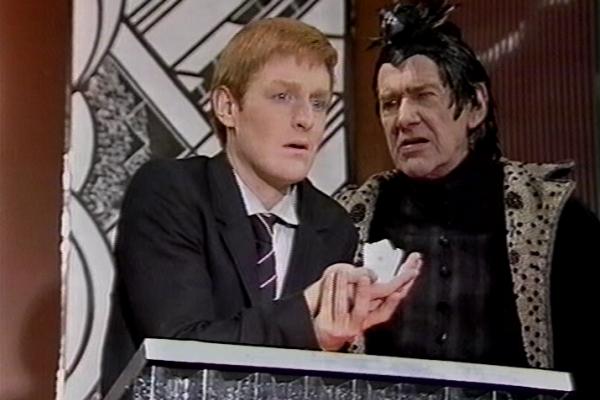
Mawdryn Undead was the opening of a trilogy of stories that introduced a companion who intended to kill the Doctor, being led on by an old enemy, 1979's the Black Guardian. While Valentine Dyall's Guardian is distractingly hammy, Mark Strickson is winningly so as new companion Turlough, a manipulative, duplicitous creation always out for his own ends. Sadly, the companion had nowhere to go after his arc with the Black Guardian was concluded, and he spent most of his ten stories being locked up by scriptwriters who didn't know what to do with him.
That thankfully doesn't apply here, as he gets a strong share of the action in a story that touches on the nature of individual timelines affecting each other. As the Doctor's companions arrive in 1977 their actions have direct repercussions on the Doctor in 1983, an interesting - and, for the original series, rare - take on the nature of time. Also back is Nicholas Courtney as the Brigadier, now retired from the army and acting as a schoolteacher. Although it was the character's first appearance for eight years, it doesn't feel as fannish as other examples of the period, and is a nice chance to catch up with a character naturally, rather than have them crowbarred into a plot for the sake of a continuity-pleasing stunt.
For all the strong material in Mawdryn Undead, however, it does always ultimately feel a little hollow - Peter Moffat's lacklustre direction and pacing contrast badly with the inappropriate incidental music, while the threat involved is non-specific and the plot resolution hugely contrived. Like a lot of Davison stories it contains innovative ideas and the genuine charm that the series used to have, but you can't help but think it could have been even better.
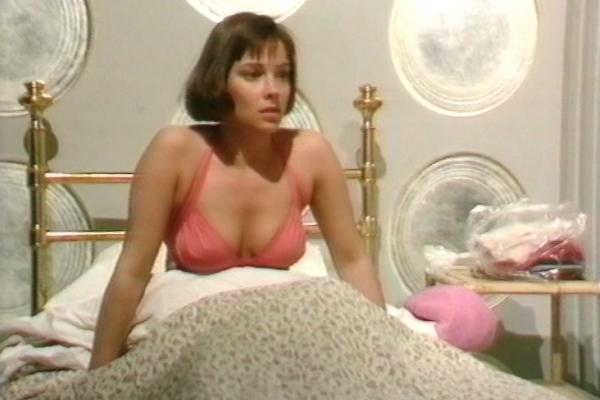
Where Planet of Fire succeeds is in being low key. With a checklist that includes the exit of Turlough, the introduction of Peri, Lanzarote location filming, a Peter Wyngarde guest star role and the deaths of Kamelion and the Master, it could have been heavily overloaded. As it stands, this penultimate Davison story is a well structured, naturally progressing tale that never feels forced in what it has to do.
It helps that Wyngarde is cast against type in a non-flamboyant role, and even Antony Ainley gives one of his best performances, over the top but without undermining the integrity of the story. And although the story itself wasn't the most original, or even the first time in the show an archaic religion had been based around a sacred flame, it tells its story efficiently and well. Sadly, a lot of the power of this one was retrospectively undone: it concludes with Davison standing impassively by as he watches the Master finally die, the Doctor almost overcome with darkness at the conclusion.
Yet the Master was inexplicably resurrected just the following year, making it seem like "just another story" in hindsight. As for the companions, then the signs for the future weren't great, with Peri Brown a return to the more generic type of assistant, where the most variable thing about her was her shaky "American" accent. And although her sexuality, as pictured, was much played upon in the series, and she was the first conpanion to openly express feelings of attraction for the Doctor (in the first post-Davison story, The Twin Dilemma) it was a role without much forethought or planning.
In fact, the character was so underdeveloped she became more known for her chest than her views, even though Bryant was, while generously proportioned, just an average sized woman forced to wear demeaning outfits rather than the uber-breasted creature of fan lore. This is what happens when 80% of companions are skinnier than average, creating a false view of womanhood.
Though the biggest companion question thrown up by this story is, of course, why Turlough is a political exile on the run from his own people... when he'd previously asked on two separate occasions if he could return to his home planet. Planet of Fire is a good Doctor Who story and Turlough, while given little to do in 1984, was a good companion. But script editing was not a strength of the series in the mid 80s, and this particular piece of miscontinuity shows why.
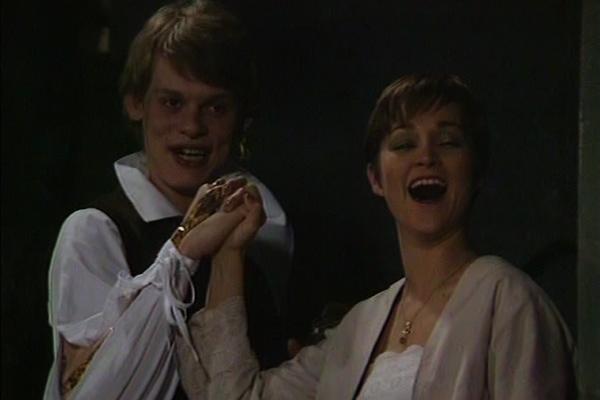
"Do you gaze upon the unspeakable? Dare you come face to face with the finally unfaceable? ... children half price." Christopher Bailey brought a lot of literary worth to his two Doctor Who scripts (even if he does borrow a line or two from TS Eliot for this one). Snakedance is the sequel to the previous year's Kinda, where an essence attacks the crew not with brute force, but by manipulating Tegan on the threshold of her consciousness. It's wonderful stuff, an entire civilisation recreated in the studio, reflecting the dream-like nature of events.
There's also an attempt by Bailey to give the somewhat static '83 TARDIS crew a bit of a shake up: Davison is more animated than in any other story, while Nyssa has a curiously needy/peeved quality to her characterisation, wanting the Doctor's (romantic?) attention and irritated when she doesn't get it. It's a curious retooling of her character, as in most of the stories she didn't really have one outside of her test tubes.
Headlining the entire thing is Martin Clunes, then an unknown novice actor, but in 2012 more famous than anyone else in the production. The narrative to this one is less layered and more single-minded in its aims than Kinda, but it's a fine follow up with a great set of scripts.
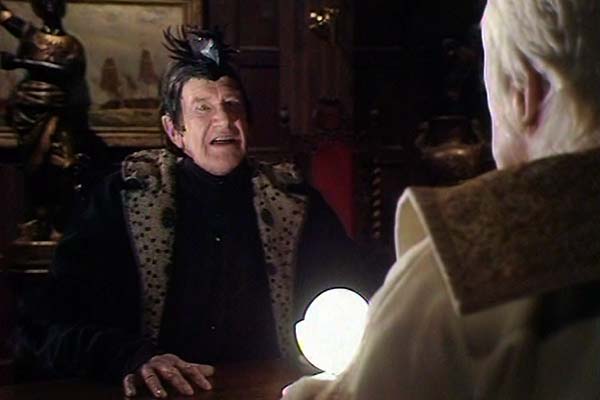
Supremely inspired stuff, as Edwardian sailing ships travel in space, beings from outside of time can read the thoughts of others, and Keith Barron brings his A Game. Okay, it does get a little panto whenever Lynda Barron and Leee John appear, and the offscreen plot resolution can seem anticlimactic, but there's so much to enjoy when Doctor Who is ideas-led like this.
The direction's strong, the music highly memorable, and we get Mark Strickson's finest-ever scene steal with the lovably hammy "I wasn't spyiiiiiiiiiiiiiiiiiIIIIIIIIIIIIIIIIIIIIIIIIIIIIIIIIIIng!" Speaking of Strickson, this was the final story in the Turlough-Black Guardian arc, so it's something of a shame he became a spare part after this story. With musings on the nature of time, memory and existence this really is a strong entry in the Doctor Who canon, leaving just one unexplained question... did anyone get that pig joke?
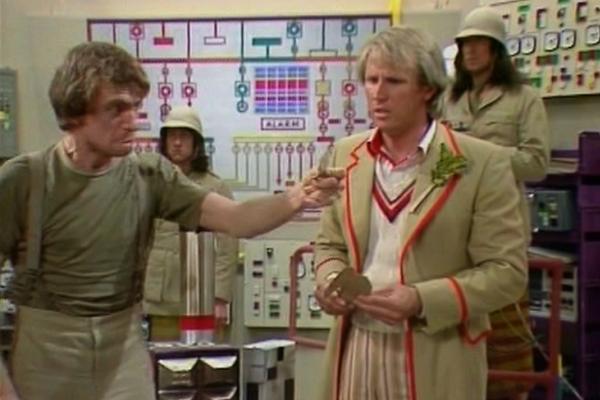
Yes there's a terrible rubber snake at the end of this story. Yes the production values aren't the greatest the show ever had. And yes, there's a dining scene where Matthew Waterhouse eats like a man who has never been in possession of a pair of hands. But if Doctor Who was always about the triumph of ideas over presentation, then Kinda is one of its finest moments: you've got religious allegory, psychic violation, a telepathic tribe with a DNA helix on their necks, the nature of mirrors, phallic symbolism, discussion of existentialism and exploration of insanity.
You've also got some standout performances, including Mary Morris and Simon Rouse. To cap it all, "you can't mend people, can you? YOU CAN'T MEND PEOPLEEEEEEE!" may be the greatest thing anyone has ever said in the history of the English language. If there's one real flaw with Kinda it's that it may contain little to appeal to the younger members of the audience: this is very much Doctor Who aimed at an intelligent, adult viewership and wholly rewarding because of it.
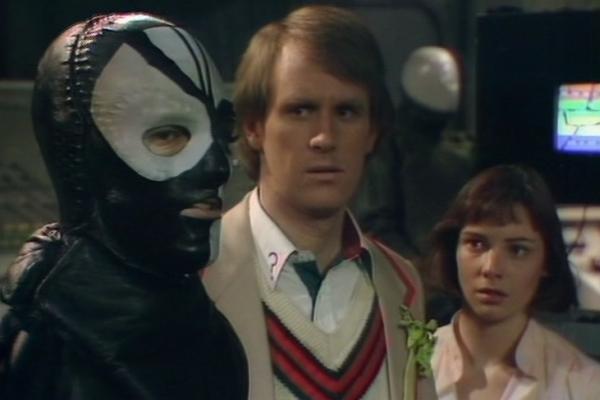
I really wanted to award Kinda first place, but sometimes clichés become clichés because they're true. The Caves of Androzani being not just Davison's finest story, but arguably the finest Doctor Who story of all, is one such cliché. This was the third attempt in Davison's final season to build a story around the concept of the Doctor being the lone nice guy in a fundamentally nihilistic universe. It pushes the ethos of the programme into uncertain new areas, but with a writer of Robert Holmes' class it works superbly.
Made during a time where the crack epidemic was starting to emerge, the UK was selling arms to Middle Eastern countries and a miner's strike became official a week after it finished airing, this tale of gun running, plant closures and trading of white powder could not be more opportune in its timing. It helps that it's directed by Graeme Harper, a man who shakes up the somewhat languid style of this era by introducing handhelds, mixes and crossfades to a serial brimming with operatic intent. Add to this the cast bringing their best, some fine incidental music and nice themes of fate and redemption and you've got a classic on your hands. Not bad for a story about two guys arguing in portakabins.